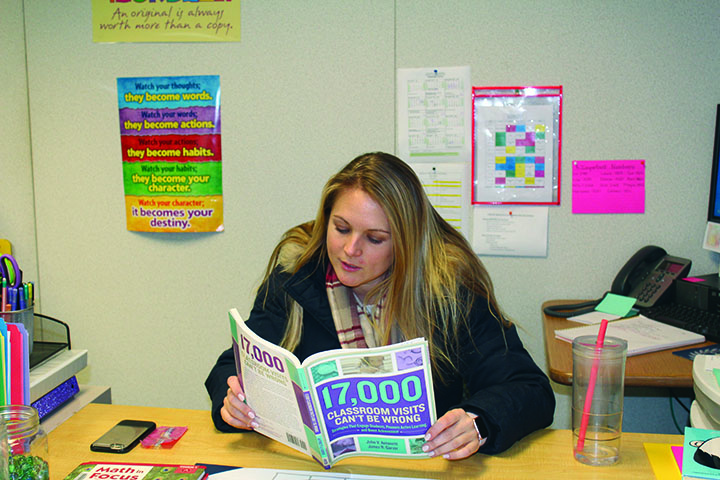Learning to Improve Student Engagement
Ms. Emily Hoyt doing her own homework reading John Antonetti’s book about active learning.
Have you noticed any teachers walk through your classroom? Were you wondering what they were doing, peering over your shoulder? These are called learning walks, but really, what are they?
According to Diane McCabe, a union representative of the Connecticut Teachers Association, the point of learning walks are for teachers and staff members to see how other teachers incorporate lessons into their classrooms. Although BMS teachers have collected limited data because the district has started doing it just this year, other school districts have found that teachers learn a lot from these walkthroughs.
Currently, mostly administrators have completed walkthroughs, but the goal is to figure out a way to get teachers and any staff member visiting classrooms. In order for all staff members to be able to partake in these learning walks, schedules will need to be created in order to make them run smoothly.
As stated by the Principal, Dr. Adam Rosen, these learning walks were brought to the school district by John Antonetti, who wrote a book about these teacher walkthroughs, and then proceeded to come to the Westport district and taught all administrators, teachers, coaches, and all staff how to partake in these learning walks.
Dr. Rosen, along with the teachers doing these walkthroughs, have yet to see an impact from them, but they hope that in years to come all staff members will benefit. “Yes, these learning walks will eventually have a great impact on students. Learning walks are not designed to evaluate teachers, they were designed to look at the kind of work students are given, and ask the question of, is this work rigorous, or not? Rigor is defined when students are making meaning,” said Dr. Rosen.
Currently, more than half of the staff has taken part in these walkthroughs, but the goal is to have all staff members do a learning walk, at least once. The visit only takes minutes; two to three teachers go into a classroom, and try to see if they can see what type of work the students are doing.
After the learning walk, all teachers pull out a rubric from John Antonetti’s book. The rubric is split into four sections, sections 1 and 2 are learning activities like recall taking notes, or restating known knowledge. However, certain class activities can be placed in sections 3 and 4. These classes were “making meaning.” Although many rubrics designed with “1,2,3,4” portray that “4” would be best and “1” would be least, this rubric is different. No numbers are better than the ones left or right of each other, “This was the big ah-ha moment when staff were taught, and began to realize this,” said Dr. Rosen. When classrooms fall on the right side of the rubric, this means that they are “making meaning,” and this is known as the “rigor divide.” The goal for classrooms is to have 20 percent of the tasks land on the right side.
Learning walks have three rules.
Do no harm: No interrupting and don’t make teachers or students feel as if they are being criticized.
Have fun: Enjoy the opportunity to look and analyze learning, without being responsible for any students.
No feedback: This is a process of self reflection, it is all about professional development.
Dr. Rosen concluded, “Learning walks focus directly on professional development; they are not for evaluating teachers.”



